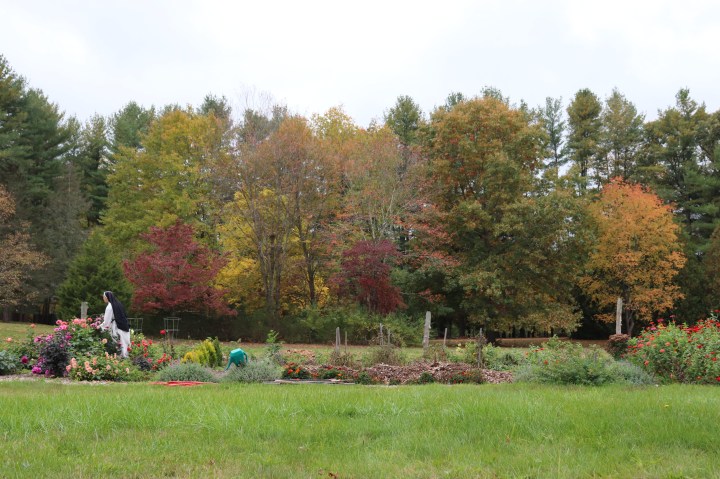Deep in the Connecticut woods lies a secluded and beautiful monastery. The Dominican nuns who live in the cloister there practice silence and solitude, devoting their lives to praising God.
Now, for the first time, the nuns at the Monastery of Our Lady of Grace are sharing photos from their history inside the enclosure in honor of their 75th Jubilee.
The photos had lain buried for decades. That is, until a young sister who serves as the community photographer had the idea to dig through them.
“I’ll pull this thread and see where it leads,” said Sister Mary Danielle, OP, of the idea to excavate the old photos. “Where it led was an avalanche!”

Some of the pictures were pasted into old albums, but most were loose in old-fashioned cardboard boxes stored inside metal army-surplus cabinets that have been in the monastery since 1958.
The photos were originally taken to form a record of the community’s life. “Photography has an important role to play in preserving our communal memory,” Sister Mary Danielle explained.
The very earliest black-and-white photos were taken by a young nun, Sr. Margaret Mary, OP, who brought her camera with her when she entered the monastery at 16 (!). Some of the older sisters still remember her taking these photos.

To the delight of them all, finding the photos became a beautiful opportunity for older sisters to share their treasured memories and stories.
“Pictures can elicit stories we’ve forgotten to tell,” said Sister Mary Danielle. “Those are some of my favorite moments.”
She recalled sharing a 60-year-old photo with an elderly sister who exclaimed, “I remember that day! Sister on my left was brooding like a storm cloud!”
This is the beauty of sharing these old photos as a community: “Suddenly I have this insight into the scene that I didn’t have before, and I can enter into it.”
She was amazed to find photos of the sisters watching television, “something that would still be exceptional for us today.” Then she realized that she knew why, thanks to the regular records or “community chronicles” that the sisters keep of their shared life.

“Right now, we are reading these stories aloud at our evening meals, straight through from 1947 to today. It’s captivating,” she said.
In the records from 1963, the Chronicler (yes, it’s an official position!) had written “how the sisters were devastated at the news of JFK’s assassination, just like the rest of America.” So the nuns received special permission to view his funeral Mass on television.

“The picture shows the nuns gathered in the community room with the windows boarded up to block the daylight. A small television is their focal point and the whole group is attentive and subdued,” Sister explained. “It’s striking when you realize what this moment meant to them.”
The sisters’ simple way of life makes it necessary to record these stories and photos and then share them with the next generation. “We don’t just store data, we have stories we want to tell and retell,” Sister said.
“Two of the most important stories in our community are the night the monastery burned down in 1955, when three sisters lost their lives, and the foundation of our daughter monastery in Kenya in 1965, the first contemplative monastery in that country. Pictures enter into this storytelling in a big way because they make these events vivid again.”

The best part for all of us outside the monastery is that the sisters are sharing these images with us. The photos show glimpses of their life in a way that’s almost never available to the public.
The Monastery of Our Lady of Grace is a strictly cloistered contemplative monastery with papal enclosure, which means norms for entrance and egress of persons are subject directly to the Holy See. So it’s extremely rare for anyone other than the sisters to witness their daily life of liturgical prayer, lectio divina, work, community recreation, and study.

Of course, there is a certain art and finesse needed to discern what should be shared and what should be private. “This requires care and prudence,” she said.
But the sisters find that these images can be a striking way to share their community. “The idea is to give people a little experience of our way of life,” Sister said. “Perhaps an image will elicit a desire for simplicity, solitude, and silence in someone who has not heeded the divine call before. In this sense, sharing our cloistered life in photos is an invitation for all people of good will to seek deeper intimacy with God.”

The photos also help to promote vocations and help the sisters’ friends and benefactors understand their way of life. An image can share the sisters’ life in a more direct way than words alone.
“Pictures like this can capture elements of our life that might otherwise take a lot of explaining. They can convey our Dominican charism, monastic stability, fraternal life, liturgy, work, and even the sheer gratuitousness of living totally for divine love. Ultimately I hope these pictures point to the Truth who is the reason for our cloistered life.”

You can see the images at dominicannuns.org, and these are only a handful of the many photos that Sister Mary Danielle and others have taken of the community. But most of them won’t be shared with the public anytime soon.
“I have some really fabulous pictures of the sisters that as a photographer I am very proud of. And do you know what’s going to happen to those pictures? They’re going into the same albums, in the same metal cabinets, in the same workroom where our community photos have been stacking up for 75 years. Maybe if you’re around for the monastery’s 150th jubilee, you’ll see a sight!”



